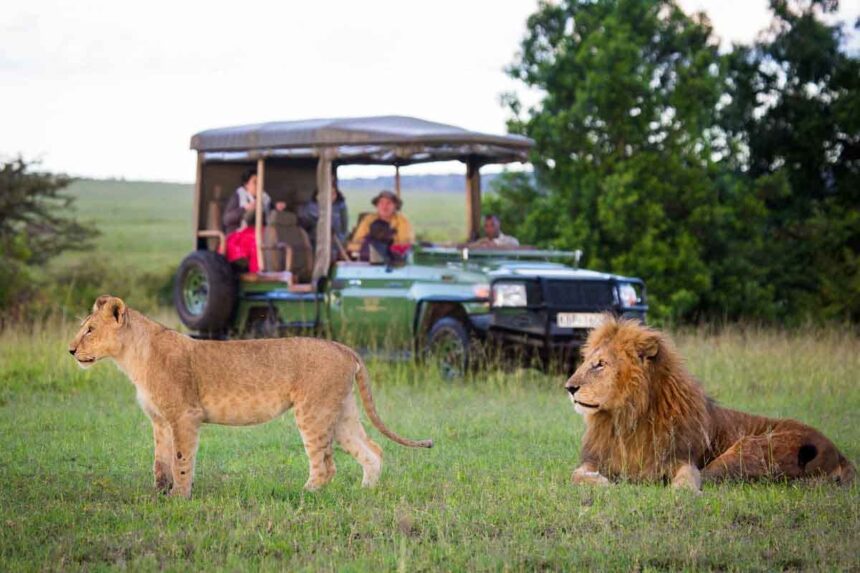The Great Wildebeest Migration is one of the most spectacular wildlife events on Earth, drawing adventurers and nature enthusiasts from around the world. This annual movement of over 1.5 million wildebeest, accompanied by hundreds of thousands of zebras and gazelles, traverses the vast plains of the Serengeti in Tanzania and the Maasai Mara in Kenya. The migration is not only a natural wonder but also one of the most iconic safari experiences, offering visitors a chance to witness dramatic river crossings, predator-prey interactions, and breathtaking landscapes.
For those seeking a truly unforgettable safari experience, Wildebeest Migration Safaris provide the perfect opportunity to immerse yourself in Africa’s most thrilling wildlife spectacle. Here’s everything you need to know about the wildebeest migration and why a migration safari should be on your bucket list.
What is the Wildebeest Migration?
The Great Wildebeest Migration is an ongoing cycle of movement, driven by the animals’ need for fresh grazing and water. Over the course of the year, wildebeest, along with zebras and gazelles, journey across the Serengeti and Maasai Mara ecosystems, covering nearly 1,200 miles in search of food and water. This migration is fueled by the seasonal rains and the growth of fresh grasses.
As the dry season sets in, the herds move northwards to the Maasai Mara, where they cross treacherous rivers teeming with crocodiles, before returning south to the Serengeti as the rains bring new life to the plains. Along the way, they face numerous challenges, including predators like lions, cheetahs, and hyenas, making the migration a dramatic and high-stakes event in the African wilderness.
The Migration Cycle: Key Stages of the Wildebeest Journey
The migration can be seen at various stages throughout the year, depending on where the herds are in their cycle. Each stage of the journey offers unique experiences for safari-goers:
- Calving Season (January to March)
In the southern Serengeti, calving season occurs from January to March, when over 500,000 wildebeest calves are born. This period is a prime time for predator-prey interactions, as lions, cheetahs, and hyenas take advantage of the abundance of vulnerable newborns. For photographers and wildlife enthusiasts, this is a great opportunity to witness the circle of life as young wildebeests take their first steps, while predators lurk nearby.
- Western Serengeti (April to June)
As the rains end in the southern Serengeti, the herds begin their northward migration toward the Grumeti River. This region is known for its lush grasslands and rolling hills, offering a scenic backdrop for game drives. During this time, the herds face their first major challenge: crossing the Grumeti River, where crocodiles wait to ambush the wildebeest.
- River Crossings (July to October)
The most iconic and dramatic part of the wildebeest migration is the Mara River crossing, which typically occurs between July and October. This stage takes place along the northern Serengeti and Maasai Mara, where the herds must navigate one of the most dangerous parts of their journey. Wildebeests and zebras gather at the riverbanks, hesitating before plunging into the water, where hungry crocodiles lie in wait.
The river crossings are a highlight for many safari-goers, offering a heart-pounding spectacle as thousands of wildebeests and zebras charge across the river. The sheer scale of the migration, combined with the tension and danger, makes this a once-in-a-lifetime experience.
- Return to the Serengeti (November to December)
As the short rains return to the Serengeti in November, the herds begin their journey back south. This period is less dramatic than the river crossings but offers excellent opportunities to witness the animals on the move across the open plains. The Serengeti’s vast, golden landscapes provide a striking contrast to the lush green season, making this a picturesque time for a safari.
Why Choose a Wildebeest Migration Safari?
- Witness Nature’s Greatest Spectacle
The Great Migration is often referred to as “the greatest show on Earth” due to its scale, drama, and beauty. From the mass movement of animals to the intense river crossings and predator-prey interactions, every moment of the migration offers something new and awe-inspiring. A Wildebeest Migration Safari allows you to witness these events up close, offering unparalleled access to one of nature’s most incredible phenomena.
- Experience the Best of East Africa’s Wildlife
In addition to the wildebeest, a migration safari gives you the chance to see some of Africa’s most iconic wildlife, including lions, elephants, cheetahs, giraffes, and rhinos. The Serengeti and Maasai Mara are renowned for their rich biodiversity, and the migration season brings heightened activity as predators follow the herds in search of prey. This makes it an excellent time for wildlife viewing and photography.
- Luxury Accommodations in the Heart of the Action
Wildebeest Migration Safaris offer a range of accommodation options, from luxury lodges to mobile tented camps that follow the movement of the herds. Staying in these camps puts you right in the heart of the migration, allowing you to wake up to the sound of wildebeest and witness wildlife from the comfort of your tent or lodge. Luxury safari camps also offer gourmet dining, comfortable suites, and personalized service, ensuring that your adventure is as relaxing as it is thrilling.
- Expert Guides and Customizable Itineraries
A Wildebeest Migration Safari is typically led by expert guides who know the migration patterns and can position you in the best locations for wildlife viewing. Many safari operators offer customizable itineraries, allowing you to tailor your trip to match your interests. Whether you want to focus on photography, enjoy family-friendly activities, or explore both the Serengeti and Maasai Mara, a migration safari can be adapted to suit your needs.
Best Time to Plan Your Wildebeest Migration Safari
The best time to see the migration depends on what aspect of the journey you want to witness. For calving season, visit between January and March in the southern Serengeti. The dramatic river crossings on the Mara River occur between July and October. If you prefer the quieter periods with fewer tourists, the months of April, May, November, and December offer excellent game viewing as the herds move through the Serengeti.
Conclusion
A Wildebeest Migration Safari offers an unparalleled opportunity to witness one of nature’s most extraordinary events. From the heart-pounding river crossings to the quieter moments of grazing on the Serengeti plains, the migration is a journey of survival, adventure, and breathtaking beauty. Whether you’re an experienced safari traveler or planning your first trip to Africa, witnessing the Great Migration is an experience that will leave you in awe of the natural world.
For those looking for an unforgettable African safari, a Wildebeest Migration Safari promises excitement, luxury, and memories that will last a lifetime.


